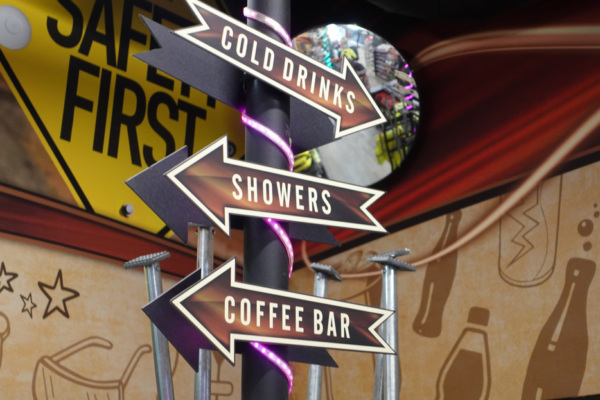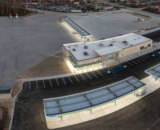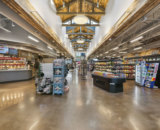Today’s travelers and professional drivers have more choices than ever along the interstate, and truckstop and travel plaza operators can grow and retain business by knowing who their customers are, understanding what they need and building in convenience.
“Ten to 12 years ago, we started seeing more and more c-stores on the interstate, specifically chains. Then those locations transitioned to travel centers,” said Darren Schulte, NATSO’s vice president of membership.
Not very long ago, travel centers had the majority of the quick service restaurants on the interstate, but that has changed. “More and more you’re seeing standalone locations on interstates,” Schulte said. “Now to get those gallons it is even a bigger challenge.”
Know Who’s Stopping
Operators have to know their customers so they can create offerings and solutions that make them stop.
“It always depends on your area and your demographic. You have to understand your customer, then you can meet their unique needs,” said Michael Lawshe, CEO of Paragon Solutions, a NATSO Chairman’s Circle Member. “Every site is different, and every demographic is different, so every solution is different. The process is take a step back, study it, understand your customers’ needs and strive to meet those needs.”
The explosive growth of last-mile delivery volumes continued in 2021. According to the 2022 State of Logistics Report, e-commerce grew by 10 percent to $871 billion—13 percent of all U.S. retail sales. That has caused companies to position goods closer to consumers for faster shipping and shortened the length of haul.
Shorter routes can change what drivers need on the road. “The freight may be going the same distance, but there are more trailer drops happening. There is more of a Pony Express model and an increase of intrastate versus interstate drivers,” Schulte said.
There has been an increase in last-mile deliveries and the number of box trucks being used. “It is not uncommon for operators to see their forecourt full of box trucks,” Schulte said.
Plus, equipment manufacturers have been increasing fuel efficiency. The American Transportation Research Institute reported that the overall average fuel economy for heavy-duty Class 8 trucks increased to 6.65 miles per gallon from 6.53 a year ago. Those mile-per-gallon improvements mean drivers don’t have to stop for fuel as often.
Lawshe said he has seen increased demand for pre-paid and reserved parking, so drivers know where they are going to park for the night. There is also increased need for short-term parking.
“If drivers are not fueling, they can park, come in, buy grab and go, hit the restroom, and get in and out,” Lawshe said, adding that often the closest parking to the location is 300 feet from the door. “We are re-thinking the short repeat trips. The demographic needs change your site planning, the interior of the store, and the products and services you offer.”
Grab and go sales have increased as drivers are increasingly pressed for time, and some locations are taking out sit down dining and reinventing the food service experience, Lawshe said. Drivers are also picking up multiple meals at a time. For example, a driver who stops in to pick up a breakfast sandwich will also pick up lunch if it is something that holds well.
Interestingly, more and more drivers are becoming owner operators. The Federal Motor Carrier Safety Administration reported that in the past three years, the number of for-hire interstate carriers with a single truck has increased by 135,000 trucks. In 2021 alone, the number of for-hire interstate carriers with a single truck increased by 85,000 trucks.
Owner operators often have more autonomy over where they stop and what they purchase, which directly affects truckstop and travel plaza operators.
“When you start looking at it, it isn’t always one thing. I would strongly suggest our members look at the big, big picture and how the entire picture is impacting them,” Schulte said. “One thing in and of itself or a couple of things changing may not harm us, but when you look at the entire landscape, it is much bigger than a lot of operators have given the proper credence to.”
Attract Customers
Now more than ever, service matters. “Be considerate of drivers’ needs but understanding that their needs were different than they were five years ago,” Lawshe said.
Once operators know who they want to attract, they can design the location to bring in their business. “If we want a certain type of customer, we have to build the location to them,” Schulte said.
Women, for example, value restrooms. “If we want a female customer, we can’t build small restrooms. If we want RV customers, we have to have auto diesel at every pump and make it easy for vehicles to maneuver,” Schulte said. “If we want the professional truck driver to come in and spend money with us, we don’t want the commercial fuel lanes to be too far from the building. If want EV pickup trucks, we better have EV pull through because those drivers won’t be unhooking their trailers.”
Among local customers, drive- through, pick-up and delivery demands have increased. “They aren’t necessarily coming in and wanting to sit down for a long period of time. Your store should be a reflection of that change,” Lawshe said.
Customers increasingly want convenience, and Schulte also advised locations to evaluate options that can increase speed, such as self- checkouts or self-ordering kiosks. In addition to saving time, automation enables locations to re-deploy labor. “I hope that we understand this is an opportunity to put employees out on the floor to talk, help and guide customers,” Schulte said.
However, self-checkout changes customers’ buying habits, so impulse purchases take place at an entirely different place. “Now, he’s busy when he is at the checkout,” Lawshe said. “It has changed the experience that that customer is having at that time.”
Think About Staff
Given the labor challenges, Schulte said it is important to factor labor needs into design. “If we put a 20- door cooler in a travel center, how much time, energy and cost is associated with stocking the cooler? Could we have an 11-door cooler but focused on the right merchandise? Operations and construction have to work together when designing a location,” he said.
Other solutions could include using desert scaping rather than grass, locating the trash close to the building to save staff time, and designing restroms so they don’t have to be blocked completely for cleaning. “It could be like an airport where you block off one side at a time,” Schulte said.
Schulte also advised locations to evaluate options that can increase speed, such as self-checkouts or self-ordering kiosks. In addition to saving time, automation enables locations to re-deploy labor.
// Created for Stop Watch magazine, the magazine of the NATSO Foundation. The NATSO Foundation is the research, education and public outreach subsidiary of NATSO, Inc. The NATSO Foundation provides programs and products aimed at strengthening travel plazas’ ability to meet the needs of the traveling public through improved operational performance and business planning. Visit www.natsofoundation.org for more information. (Donate to the NATSO Foundation here.)
Subscribe to Updates
NATSO provides a breadth of information created to strengthen travel plazas’ ability to meet the needs of the travelling public in an age of disruption. This includes knowledge filled blog posts, articles and publications. If you would like to receive a digest of blog post and articles directly in your inbox, please provide your name, email and the frequency of the updates you want to receive the email digest.


